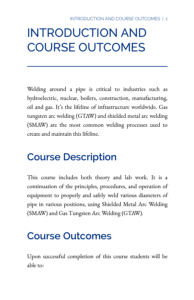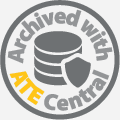
This 238-page textbook was created for the WELD 205: Advanced Pipe Welding course taught at Lake Washington Institute of Technology. The course includes theory and lab work. This textbook includes sections on pipes, welding passes, welding positions, welding methods, nondestructive examination, destructive testing, weld discontinuities, discontinuities: cracks, discontinuities: inclusions, discontinuities: cavities, and discontinuities: incorrect shapes. Upon completion of this course students should be able to do the following:
- Describe the principles and terms used in pipe and tube welding
- Use math to make equipment adjustments/calibrations and to complete fabrication projects
- Select and safely set up SMAW and GTAW pipe welding equipment
- Store, transport, and handle all types of SMAW and GTAW equipment properly and safely
- Prepare metal for shielded metal arc pipe welding procedures using proper joint design, equipment, and joint preparation techniques
- Use technical resources to access information regarding welding and fabrication processes
- Follow industry standard safe practices, including the using and wearing of all safety equipment needed to weld or be in a welding environment
- Complete a resume, cover letter, job application, and job search as necessary
- Select the proper metals and consumable materials, including electrodes, wire, filler metal, and/or shielding gases, for various welding tasks by using metallurgy principles
- Prepare metal for welding or cutting procedures using proper equipment and joint preparation techniques for ferrous and non-ferrous metals
- Use welding machines, shop equipment, and hand tools to safely perform welding and/or fabrication procedures
- Select, assemble, and adjust welding machines for various processes to produce welds that meet AWS standards
- Demonstrate the ability to start an arc, run a bead, and assess a weld puddle
- Use proper welding techniques to produce welds on lap joints, corner joints, T-joints, and/or butt joints in a variety of positions, including 1F, 2F, 3F, and 4F and/or 1G, 2G, 3G, and 6G
- Use math to make equipment adjustments and/or calibrations and to complete fabrication projects
- Use visual inspection methods and/or destructive testing to identify defects and/or discontinuities
- Follow ANSI Z49 safety standards, including recommended practices for personal protective equipment and hazardous material laws/processes
About this Resource
Publisher
Date Issued
2024
Resource Type
Audience
Education Level
Language

Subject
GEM Subject
Subject
Relation
Associated Files
Archived
STEMLink
Available in STEMLink
Comments